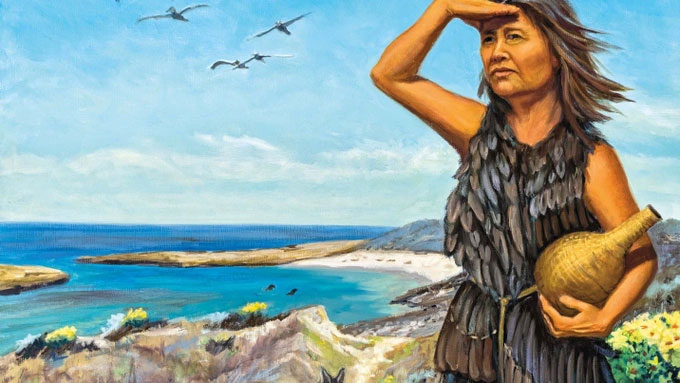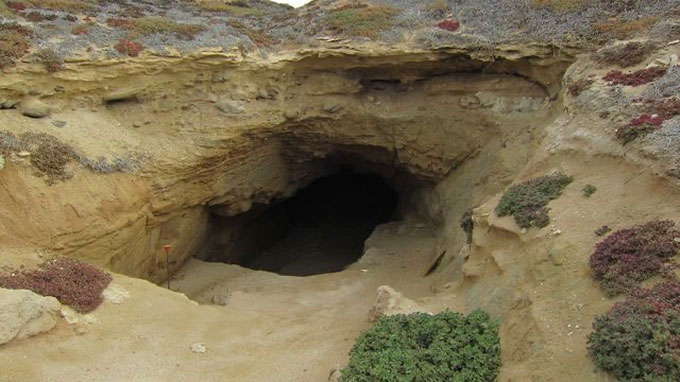Revealing the mystery of the woman who lived alone for nearly two decades on a deserted island
The mysterious woman lives alone on the island of San Nicolas, after narrowly escaping a massacre of her tribe. Her story has received attention from researchers with surprising revelations.
In 1853, a group of otter hunters from Santa Barbara, California, USA, came to one of the most remote islands in the Channel Islands of this country, they discovered a woman about 50 years old, speaking a language that no one could understand.

Illustration of the mysterious woman who lived on San Nicolas Island for nearly two decades. (Photo: Halmon).
Many rumors and slanders about this mysterious woman were spread in American society at that time and it aroused the curiosity of archaeologists, linguists, and historians. Their research revealed many surprising details.
Many theories have been put forward and it is possible that Maria (the woman's posthumous name) was the last member of the Nicoleño tribe living on the islands.
In addition, this woman may have lived alone for 18 years in San Nicolas. It has created a fascinating historical story. The details of Maria's life have been and are being explored by historians and archaeologists with many things being revealed.
The tribe was massacred.
The Channel Islands lie about 60 miles off the coast of California, in icy waters. San Nicolas Island is the most remote island in the archipelago, and was once used by the US Navy for weapons testing.
In the 19th century, it was home to Native Americans who had lived there for thousands of years and were known to Spanish colonists as the Nicoleño tribe.

A cave on San Nicolas Island is believed to be the home of this mysterious woman. (Photo: Andrea Howry).
The remote island, covered in sand dunes, was largely overlooked by early European explorers. Beginning in 1814, when Russian otter hunters landed on San Nicolas in search of valuable furs, they massacred more than 90% of the Nicoleño tribe that lived on the island.
Some contemporary documents reveal that the cause of this massacre was because the Nicoleño tribe killed a member of this hunting party when they set foot on the island.
By 1835, the surviving Nicoleños were rescued aboard a sailing ship bound for Los Angeles, while the islands' rich otter population had been hunted almost to extinction.
The Nicoleño tribe has left their ancestral home, but one person remains.
In 1853, after rumors emerged from a group of otter hunters from the city of Santa Barbara about this mysterious woman, an expedition led by American scientists found and "rescued" her in a costume of a green cormorant feather dress.
On the island, they followed and discovered that the woman lived in a hut made from whale bones or slept in caves and Maria's daily food source came from sparrows, seals, roots, abalone,.

Abalone is one of the daily dishes of women. (Illustration photo).
Maria was then brought back to the mainland to live in a clay brick house in Santa Barbara, but she seemed unable to adapt to the environment there.
The language barrier, as well as the epidemic on the mainland (for which she may not have been vaccinated), caused Maria to die seven weeks after her rescue. Before her death, a Catholic missionary named her " Juana Maria".
Maria's story, with its wild island solitude, natural beauty, native grit and tragic fate, caught the attention of writer Scott O'Dell, author of the book "Island of the Blue Dolphins" , published in 1960 based on this true story.
The book fictionalizes the lonely woman as a resilient teenager named Karana, creating a portrait of a girl coming of age and facing extreme hardship.
The truth is gradually revealed
In the early 20th century, archaeologists returned to San Nicolas Island to search for more information about Juana Maria. They surveyed more than 500 sites on the island, discovering some ruins such as a whale bone hut, which seemed to be the house Maria had built before.

A mound containing seashells discovered by a team of archaeologists on San Nicolas Island. (Photo: Hanson).
Archaeological and genetic evidence suggests that the Nicoleño tribe on San Nicolas Island may have been inhabited for around 8,000 years . Remains on the island, from arrowheads to caves marked with images of whales, suggest that their culture was closely connected to the ocean, with their hunting of marine animals.
Remarkably, according to scientists, from the 17th century onwards, it seems that this tribe accepted the existence of otter hunters from Mexico, Russia, Alaska and other parts of the world.

Santa Barbara Island is one of the closest islands to San Nicolas.
Santa Barbara Island is one of the closest islands to San Nicolas. Archaeologists believe that the Nicoleño and other peoples may have visited it seasonally to fish and harvest mollusks but did not settle there.
Dr. Susan Morris, a historian, has spent years dispelling myths and skepticism about Maria. Her team has tracked down the Nicoleños who left the island in 1835 and discovered that at least seven of them settled in Los Angeles and thrived.
Among them, there was one named Tomás , who outlived Maria, disproving the theory that she was the last of her tribe.
Additionally, claims that no one could communicate with her are also incorrect. Linguists have studied Maria's spoken dialect as belonging to the Takic branch of languages (now known as Californian languages).
This woman managed to talk to people who could understand her, while trying to share her stories.
Evidence has shown that the story of the white men bringing the lonely woman to Santa Barbara and the reason she stayed on the island because of a lost baby, which was then eaten by wild dogs, is completely fabricated.
Dr. Morris and colleagues consulted the notes of ethnologist John Peabody Harrington, who interviewed several California tribespeople about the woman's story in the late 19th century, and discovered that she had indeed been on the island with her son.
For many years, the couple thrived together on the island. The mother only left San Nicolas after the tragic death of her son, which historians believe may have been caused by a shark attack.
Today, scholars are still learning more about the vibrant cultures that thrived on California's Channel Islands. The islands' inhabitants are linked to the Gabrieleños, indigenous people recruited by Spanish missionaries to work at the San Gabriel church in the 1700s.
The search for more information about the mysterious woman continues. Morris's team is now turning their attention to finding surviving descendants of the tribe, who she believes may be living in Los Angeles.
'They have lived on this land for thousands of years and they continue to live to this day ,' researcher Morris added.
- No one dared to set foot in the middle of New York
- Revealing the face of a Neanderthal woman 75,000 years ago
- The mysterious, inexplicable mystery on the uninhabited island: The Soviet Union decodes but fails
- The remains of the medieval woman are over 2m high in Poland
- Revealing how extinct 'dodge' mammoths lived for 10,000 years
- Evidence of the deserted island of Alexander Selkirk
- Mysterious beautiful island carries a curse of death
- Revealing the mystery of the statue on Easter Island
- The mystery of a woman's hair is still black even though she died 3,000 years
- Top 12 dishes that centenarians on the Greek island of longevity often eat: 11 of them are available at Vietnamese markets!
- The truth about the desert island where Robinson once lived
- The mystery of a huge treasure worth more than 120 million USD on an island in the Indian Ocean
 'Fine laughs' - Scary and painful torture in ancient times
'Fine laughs' - Scary and painful torture in ancient times The sequence of numbers 142857 of the Egyptian pyramids is known as the strangest number in the world - Why?
The sequence of numbers 142857 of the Egyptian pyramids is known as the strangest number in the world - Why? History of the iron
History of the iron What is alum?
What is alum?